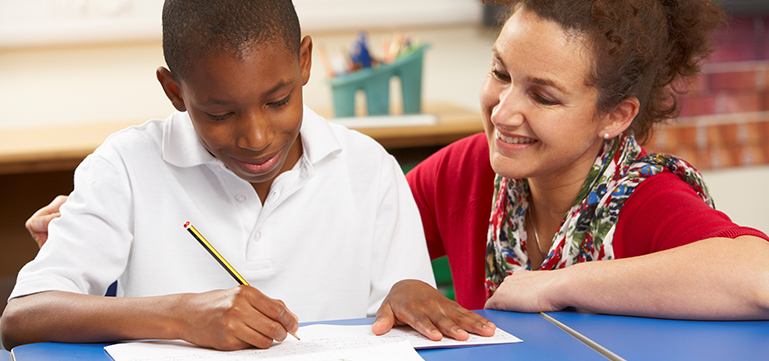Including all staff in the self-evaluation process

Quick links:
Information about the school
St Mary’s R.C. Primary School is in Wrexham local authority. There are 395 pupils on roll aged 3 to 11 years, including 42 who attend part-time in the nursery. The school organises pupils into 14 single-age classes and two nursery classes. About 5% of pupils are eligible for free school meals, which is considerably below the national average of 18%. The school identifies about 8% of pupils as having additional learning needs which is below the national average of 21%. The majority of pupils come from an ethnic minority background and around a half the pupils have English as an additional language. This is notably above the national average of 6%. A very few pupils speak Welsh at home.
Context and background to the effective or innovative practice
The school staff are organised into teams to lead and develop priorities. This has proved successful, for example when implementing new initiatives within the school following their involvement in a number of collaborative, cluster-based projects.
Previously, the headteacher and senior managers were responsible for leading the school’s self-evaluation process. Whilst staff and governors were involved and aware of the SDP (school development plan) through staff and governors’ meetings and training opportunities, there was limited involvement in its creation and on-going evaluation.
In addition, the traditional role of the curriculum co-ordinator had become redundant within the school. Staff were working much more collaboratively to plan stimulating learning experiences with the pupils, and all members of staff were involved in monitoring exercises on a rota basis.
With the imminent arrival of the new Professional Teaching Standards, the leadership team recognised their professional responsibility to support and facilitate the development of all staff as leaders. Going forwards, it was vital that the self-evaluation and school development process became a whole school concern and that all staff members claimed greater ownership of their professional development.
Description of nature of strategy or activity
The school self-evaluation, its development planning and staff development is a shared responsibility of staff who work collaboratively as a professional learning organisation.
- Initially, draft school improvement priorities are identified following a robust self-evaluation process involving all staff and governors.
- Key personnel with specific responsibilities are nominated by the leadership team to lead the development of each identified priority within an SDP development team e.g. literacy coordinators, Successful Futures Cluster Lead.
- Staff are invited to express an interest in joining a particular SDP team.
- Based on this information, the leadership team then organise teachers into cross-phase teams with an appropriate balance of expertise and experience to ensure effective whole-school development of each priority.
- Each SDP team work collaboratively to evaluate and detail their specific priority area for development within the shared SDP document.
- They reflect on the current situation in relation to the priority area, identify criteria for successful implementation and document specific actions to be taken. Any staffing and resource implications are detailed, including costs and their source. Deadlines for achievement are also included.
- On completion, the SDP teams present their part of the development plan to the whole staff and any further actions are added following discussion. Links between different priorities are made to ensure a consistent and cohesive approach.
- The leadership team analyse the overall SDP and prioritise whole school development, research and training needs. This informs a planned programme of in-house action-based research activities, staff meeting workshops, training and any other staff development sessions to be provided by other key professionals.
- SDP teams are then given short-term targets for development linked to their priority, with an expectation to share research and good practice with the whole staff during a designated staff meeting and training session.
- All staff meetings and development sessions provide an open forum for staff to contribute, ask questions, and professionally challenge ideas and strategies. This ensures that systems are appropriately refined and adapted to best suit the pupils and their setting.
- Each half term, SDP teams conduct a full review of progress towards the identified actions and the SDP is updated accordingly on the shared online document. Each action is RAG (Red, Amber, Green) colour-coded and progress is evidenced. Where necessary, actions may be modified in light of any additional training or research conducted.
- All staff and governors have access to the ‘live’ SDP and it is also formally shared with governors at each curriculum and governors’ meetings. Progress is discussed and challenged where appropriate to ensure sustained improvement.
What impact has this work had on provision and learners’ standards?
- A climate of mutual support where all staff effectively collaborate on all areas of school improvement
- A shared ownership and understanding of the school’s vision for strategic development
- Successfully distributed leadership responsibilities to all staff according to their strengths and areas of interest and expertise
- Staff working in cross-phase teams, ensuring that everyone has an overview of the school’s improvement journey
- Well-defined roles and responsibilities clearly understood by all members of staff
- Staff at all levels empowered to contribute extensively to developing their own leadership skills
- Collaborative teaching and support for colleagues, providing tangible guidance for less confident or experienced staff
- Opportunities for professional learning both within and beyond the school
- A platform for staff to share good practice and provide training at a whole school level, which also successfully enhances their own presentation skills
- Innovation and professional growth at all levels, facilitated by action research conducted by SDP teams
- Higher expectation for staff to conduct research and to be responsible for their own professional learning
- Encouragement and empowerment for staff to reflect on their own practice and be open to trialling new, innovative and forward thinking pedagogy without the fear of making mistakes
How have you shared your good practice?
The school has shared the development of this leadership model with the regional consortium, the Diocese and key stakeholders.